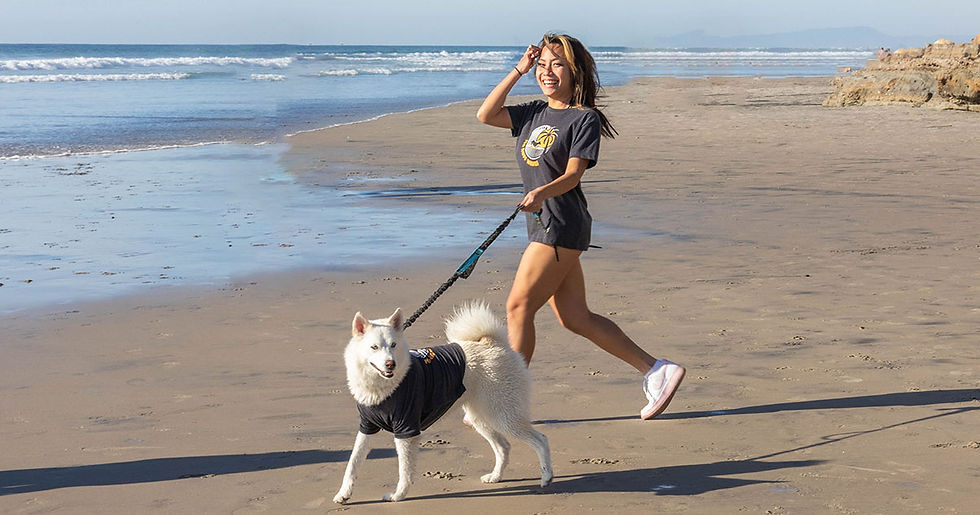
We believe that every dog walk has the potential to be an amazing adventure. In this guide, we'll discuss the benefits of walking your dog, along with preparation and safety tips, training advice, and best practices for successful walkies. Join us as we explore how you can transform your everyday walks into incredible adventures for both you and your pup.
Benefits of Walking Your Dog
Taking your dog for a walk is more than just a way to relieve boredom; it's an essential activity that enhances their well-being and deepens the bond between you. Regular walks provide your dog with necessary exercise, helping maintain a healthy weight and joint health. It also stimulates their mind, giving them the opportunity to explore scents, sights, and sounds.
Physical | -Maintain dog's healthy weight -Improve Cardio -Strengthen muscles & joints |
Mental | -Exploring provides mental enrichment -Investigate new sights & scents |
Socialization | -Interact with other dogs & people -Fosters good social behavior |
Behavioral | -Release your dog's pent up energy |
Bonding | -Creates a deeper companionship |
Stress Relief | -Walks promote relaxation & peace of mind |
Improved Digestion | -Aids in regulating the digestive tract -Can help prevent constipation |
Preparation Tips
Before setting out on any adventure with your dog, adequate preparation is key to ensuring a safe and enjoyable experience for both of you.
Finding Walking Paths

Start by exploring your local area/neighborhood for dog-friendly paths. Look for parks, trails, and community paths that are safe and welcoming for dogs. Websites and apps dedicated to outdoor activities can also provide valuable information on potential walking routes. Additionally, you can always reach out to local dog groups on social media and ask for recommendations.
Gear Needed
Unlike a lot of other outdoor adventures we cover, you won't need a ton of gear for walks. Be sure to have a sturdy leash, harness, waste bags, treats for positive reinforcement, and water for both you and your dog, especially on longer walks. Additionally, consider investing in reflective gear or LED collars for visibility during early morning or evening walks.
Leash/Harness with dog's ID
Poop bags
Treats
Water
Reflective gear (if going at low-light)
Safety Tips

Always check the weather forecast before heading out and avoid harsh conditions that could be harmful, like extreme heat or cold; remember, your dog is lower to the ground than you are, so if it's hot, they're going to feel it a lot more. Also, if the pavement/sidewalk is hot, you run the risk of burning their paws. You can walk your dog in the snow; however, make sure you limit the time and monitor your dog closely. Lastly, make sure your pup has their ID securely fastened to their collar and/or harness in case they get off leash and run away.
Training Your Dog for Walks

Not all dogs will take to the leash right away and it does take time to train them correctly and positively. Training your dog for walks should be a consistent, positive experience. Starting with short walks around the block can help build your dog’s confidence. Use treats and praise to reinforce good behavior, like walking nicely on a leash without pulling. Learn more about basic dog training commands here.
Best Practices When Taking Your Dog for a Walk

Respect leash laws and keep your dog under control. Pay attention to their body language and needs, granting rest or water as necessary. Also, practice good pet etiquette by cleaning up after your dog and ensuring they don't disturb wildlife or other people.
Make Your Walks an Adventure
To add a splash of excitement to your daily walks, turn them into mini adventures with some engaging activities. Try changing your regular route to include a mix of terrains, such as hills or hiking trails, to challenge your dog's agility and strength. You can also organize scavenger hunts by hiding treats along the route and encouraging your dog to find them, honing their sense of smell and foraging skills.
For an interactive experience, use natural features like logs and rocks for an exciting obstacle course! Or, visit dog-friendly events in your community where your dog can meet new friends. By adding these elements, every walk has the chance to be an adventure, turning routine walks into opportunities for discovery and play.
Walks are Great for Reinforcing Dog Training
Incorporate training sessions into your walk by practicing new commands or tricks. The controlled environment outside provides an excellent opportunity for reinforcing good behavior, like paying attention to you without getting distracted by other people or dogs. Encouraging your dog to stay close and follow commands on walks also helps build their recall skills, which are crucial in off-leash areas.
Let's Go For Walkies
Transforming everyday walks into adventures for your dog is all about preparation, safety, and training. These walks are invaluable for their development and your mutual enjoyment. With each stroll, you create lasting memories and contribute positively to your dog's physical and mental health.
Frequently Asked Questions
Q: How long should a daily dog walk be?
Q: Is it okay to walk my dog once a day?
Q: What should I do if my dog is reactive to other dogs or people while on a walk?
Q: What are the best times of day to walk my dog during hot weather?
Check Out Our Guide For More

We hope you've gotten value out of this chapter. Check out our online outdoor adventure guide for more exciting activities you an try. From easy (hiking) to more complex (surfing), we cover it all.

































Comments